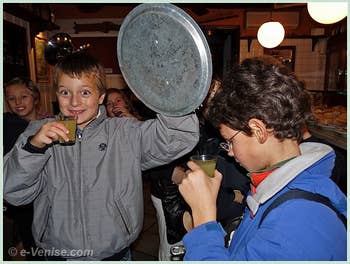What's On Celebrations | Exhibitions | Biennale | Mostra Cinema
Celebrations Historical Regatta | Redentore | Salute | Vogalonga | Marathon | Marys | St Martin
St Martin's Day in Venice
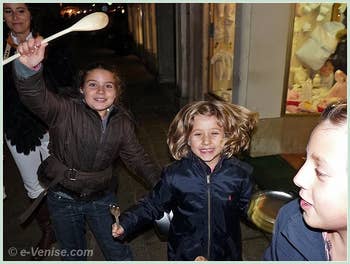
Children at Saint Martin's Day Every evening on 11 November, gangs of little Venetians wander through the Calli banging on lids and saucepans with large wooden spoons.
They redouble their strength and enthusiasm by invading shops and shops, where they sing at the top of their voices a little nursery rhyme in honour of saint Martin, the charitable horseman:
“San Martin xe 'ndà in sofita
a trovar ea nonna Rita
nona Rita non ghe gera
San Martin col cueo par tera!
E col nostro sachetin
cari signori xe San Martin”
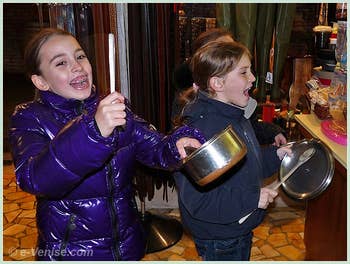
Saint Martin's Day in Venice
Saint Martin went up to the attic
To find Grandma Rita,
Grandma Rita wasn't there,
Saint Martin's ass on the floor!
And with our little bag,
Dear Sirs, it's Saint Martin's day!”
(Translation Visit-Venice-Italy.com)
Faced with such a racket, the shopkeepers hurried to offer them sweets and coins, so that they would vacate the premises as quickly as possible, under the amused and approving gaze of the customers.
On their way out, everyone deposits their harvest in a large bag carried by one of the accompanying mums, who then send them on their way to another victim: “The Pasta Shop!” or “The Bar-Pasticceria!”.
And everyone runs off in joy and good humour towards new conquests, without having time to be overcome by shyness!
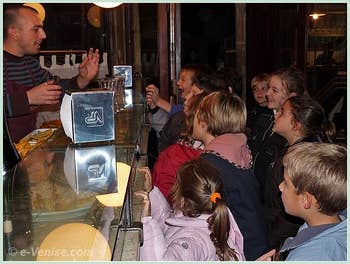
Saint Martin: take on the bartender At the end of the tour: gather round and share the spoils. And there's competition between the teams to see who gets the most!
St Martin's Day, an ancient folk festival...
In Venice, and for centuries, 11 November was a day to enjoy new wine and chestnuts, and sing the glory of Saint Martin under the windows, hoping that some kind soul would throw you some new chestnuts!But the song was a little different from the children's:
“San Martin xe 'ndà in sofita
A trovar la so'novissa
So'novissa no ghe gera
San Martin col culo par terà!”
“Saint Martin went to the attic
To find his fiancée,
His fiancée wasn't there,
Saint Martin's ass on the floor ”
(Translation Visit-Venice-Italy.com)
This sudden fall is very surprising, but here's the Oedipal explanation from Tiziano Scarpa, author in his book "Venice is a Fish":
“What does this ditty tell us?
It tells us that the saints also have an intense sentimental life, that the eternal feminine pushes us upwards, to the attic, because love draws human beings towards heaven and that, without a fiancée, we are destined to fall back into incestuous contact with mother earth.”
But we can just as easily imagine that saint Martin simply consoled himself by drinking a little too much new wine, since the barrels were opened on his feast day!
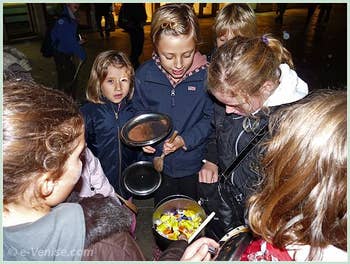
Pooling the booty!
A popular festival dating back to Greek antiquity
The tapping of barrels of new wine on 11 November is a tradition that actually dates back to Greek antiquity.Remember that the festival in honour of Bacchus lasted three days: the 11, 12 and 13 November and was called Pitigia or Pitegia, meaning “opening of the barrel”.
And Plutarch also indicates that for certain peoples, 11 November was a day of feasting and revelry.
In Venice, Saint Martin's Day was also the day for renewing rental contracts. Hence the expression: “Far Samartin”, (to make Saint Martin) which means: to move!
We should also remember that Saint Martin is the Saint protector of soldiers, tailors, innkeepers and merchants.
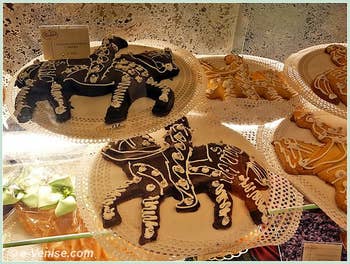
Saint Martin's Day cakes in Venice The importance of Saint Martin's Day in the Christian calendar is explained by the history, or rather the legend, of Saint Martin, who is said to have been born on 11 November.
As you can see, on the face of it, it's a bit hard to make the connection between these autumnal bacchanals and the very Christian Martin who became Bishop of Tours.
Let's go back to the story of this Saint.
The legend of Saint Martin
Martin was born in Hungary in 316, but was brought up in Pavia, as his father was a military tribune.At a very young age he attended Christian assemblies without his parents' knowledge, and at 12 he already wanted to become a catechumen, to prepare himself to receive baptism.
As the son of a Roman officer he had to serve with his father, and was conscripted at the age of 15. Following his Christian ideal, he regarded his only servant as his equal, and as a brother.
Saint Martin: the charitable horseman
Riding past the gates of Amiens on a bad weather day, one 11 November, he saw an unfortunate man dressed in rags, beaten by the rain and the wind...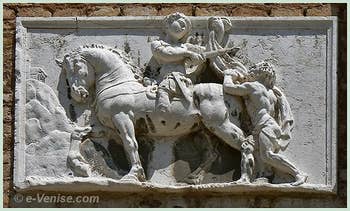
Saint Martin giving away his cloak Then Martin took off his great rider's coat and cut it in half with his sword to give half to this poor man.
Saint Martin continued on his way through the rain and the wind, which was blowing so hard that it seemed to want to tear off what was left of his cloak to protect himself.
But suddenly the wind died down and the clouds dispersed to make way for a beautiful sun that warmed the atmosphere so well, the horseman had to take off his coat...
This is the famous “summer of Saint Martin”, which is renewed every autumn by beautiful sunny spells, as a sign of the fine gesture of charity performed by the good Saint Martin, immortalised by sculptors... and Venetian pastry chefs who always depict him on horseback cutting off his cloak with his sword!
Saint Martin: bishop of Tours
Baptised at 18, he left the army as soon as he could, and went to Italy to his parents to convert them to the Christian faith.After a journey strewn with bad encounters and trials, he arrived in Pavia and converted his mother; but he failed to convert his father, who remained a pagan.
Saint Martin displayed humility and charity throughout his life.
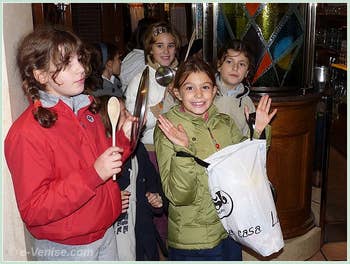
The bag is full of sweets! He left for France to join Saint Hilaire and founded the monastery of Ligugé near Poitiers while performing a few miracles.
On the death of the bishop of Tours, the city of Tours appointed Martin to succeed him, and eventually succeeded, despite the opposition of some bishops and Saint Martin's lack of enthusiasm for the position.
Saint Martin found a way to escape city life by founding the monastery of Marmoutier (or Martin's Monastery: “Mar-Moutier”), just outside Tours, where he lived by the rules of abstinence in the company of eighty disciples... who were only allowed to drink wine when they were ill!!!!
This is a far cry from the song from Northern France: “Saint Martin drinks wine in the Rue des Capucins!”, and the one from Venice, where he climbs up into the attic to see his fiancée (or nonna Rita), and falls on her bottom!!!!
Bacchus returns on St Martin's Day!
It's Bacchus's laugh returning from the depths of time, to gently tumble this saint who came to supplant Him and temper the excesses of human nature, reminding us that pleasure and joy do not prevent generosity towards one's fellow man!And Saint Martin himself knew how to show posthumous humour towards the blind and the paralytic:
“There were then, in Tours, two companions, one of whom was blind and the other paralytic.
Little Venetians at Saint Martin's Day The blind man carried the paralytic and the paralytic guided the blind man; and, living like this, they made great profit from begging.
When they heard that the body of Saint Martin was being taken in procession to the new church to be laid to rest, they feared that the procession would pass through the street where they were standing, and that Saint Martin would take it upon himself to cure them: for they told themselves that if they were cured, they would lose their livelihood.
So they thought of fleeing down a street where the procession was not likely to pass.
And as they fled, they came across the body of Saint Martin, who healed them both.
So true is it that God bestows his benefits on those who do not ask for them!”
Jacques de Voragine : “La Légende dorée” (1298)
And if you're in Venice on Saint Martin's Day, you can't help but laugh and smile at the sight of all those little blonde and brown heads running screaming and singing at the top of their lungs through the Calli and rushing to the shopkeepers, where they “dare” to do everything they're usually forbidden to do....
Celebrations Historical Regatta | Redentore | Salute | Vogalonga | Marathon | Marys | St Martin
What's On Celebrations | Exhibitions | Biennale | Mostra Cinema
Back to Top of Page


